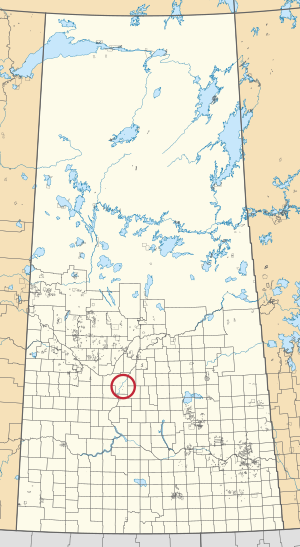Asimakaniseekan Askiy 102A facts for kids
Quick facts for kids
Asimakaniseekan Askiy 102A
|
|
|---|---|
| Asimakaniseekan Askiy Indian Reserve No. 102A | |

Location in Saskatchewan
|
|
| First Nation | Muskeg Lake |
| Country | Canada |
| Province | Saskatchewan |
| Area | |
| • Total | 14.3 ha (35.3 acre) |
Asimakaniseekan Askiy 102A is a special piece of land in Saskatchewan, Canada. It is an Indian reserve that belongs to the Muskeg Lake Cree Nation. This reserve is unique because it is an urban reserve, meaning it is located right inside the city of Saskatoon.
Contents
What is Asimakaniseekan Askiy 102A?
Asimakaniseekan Askiy 102A is a small area of land. It covers about 14.3 hectares. This land is set aside for the Muskeg Lake Cree Nation. It helps them connect with the city of Saskatoon.
Understanding Indian Reserves
An Indian reserve is a piece of land in Canada. The Canadian government sets it aside for the use of a First Nations band. These lands are for the exclusive use of First Nations people. They are meant to protect their culture and way of life.
The Idea of Urban Reserves
An urban reserve is a special kind of Indian reserve. It is located within or very close to a city. Asimakaniseekan Askiy 102A is an example of an urban reserve. It is inside the city limits of Saskatoon.
Where is it Located?
Asimakaniseekan Askiy 102A is found in the city of Saskatoon. Saskatoon is a large city in the province of Saskatchewan. This location helps the Muskeg Lake Cree Nation. It allows them to take part in city life and business.
Who are the Muskeg Lake Cree Nation?
The Muskeg Lake Cree Nation is a First Nations group. They are part of the larger Cree family. Their main reserve is Muskeg Lake 102. This is located about 100 kilometers north of Saskatoon. Asimakaniseekan Askiy 102A is one of their newer reserves.
Why are Urban Reserves Important?
Urban reserves like Asimakaniseekan Askiy 102A are very important. They help First Nations communities. They create economic opportunities. Businesses can be built on these lands. This helps create jobs and income for the First Nation.
They also help First Nations people live closer to cities. This gives them better access to services. These services include schools, hospitals, and jobs. Urban reserves help build stronger relationships. They connect First Nations and non-First Nations communities.

